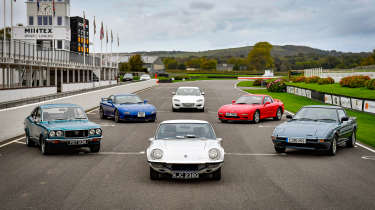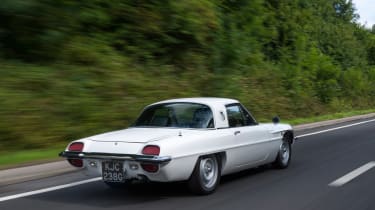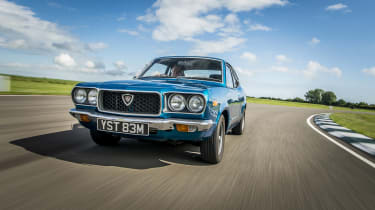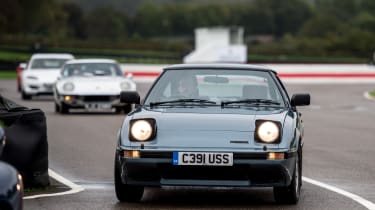Mazda rotary engine - 50 years of rotary-powered cars driven
The chance to drive six of Mazda's most appealing rotary-engined cars was too great to miss
2017 marks fifty years since Mazda produced its first Wankel rotary-engined car. There is, sadly, no 2017 Mazda RX-anything to celebrate that fact, but thankfully the Hiroshima-based manufacturer has a rich back-catalogue of rotary vehicles and, perhaps even more thankfully, Mazda UK has begun to add several of these to its collection as part of a renewed heritage push.
The opportunity to drive six different vehicles over the course of two days was too great to miss – particularly when it included such beauties as an ultra-rare original Mazda Cosmo and a delivery-miles first-generation RX-7. Rotary-engined cars have their fanatics and their detractors, but from this brief acquaintance, it’s hard not to conclude that the world would be a poorer place without them…
Mazda Cosmo
Not to undersell the Cosmo – Mazda’s first ever rotary production vehicle and currently a car achieving six-figure sums on the used market – but it feels very much like an MX-5. Like my own MX-5 in fact, a detail not unrelated to Mazda’s example using a similar Nardi wood-rimmed steering wheel until it can source an original.
Also known as the 110S, Mazda built around 1500 Cosmos between 1967 (this car’s a ‘68) and 1972, the majority powered by 982cc twin-rotor “10A” engines units designated 0810 and 0813. The later engine took power to 128bhp from 108, breathing through a Hitachi four-barrel carburettor and sending power through first a four-speed manual and later a five-speed to the rear wheels.
Today, it doesn’t feel quite as brisk as you’d expect of those numbers and a 940kg kerb weight. The factory claims 0-60mph in 8.7sec, which sounds about right for that power-to-weight ratio, so perhaps a little more fine-tuning would liberate the seemingly missing horses.
But this is an old car, and one that, despite being the least turbine-like of the assembled rotaries, must have been a revelation in the late 1960s. The engine does like revs, and the slick, also MX-5-like gearshift adds further delight. Perhaps most pleasing is the steering, which defies old-car expectations with its precision around the straight ahead. The houndstooth-trimmed cabin is beautiful and the styling is as rocket-like as the name suggests; a real privilege to drive.
> Rocketeer Mazda MX-5 V6 review
Mazda RX-3
The RX-3 wasn’t the next rotary Mazda produced – that fell to the R100 of 1968 – but it was one of the most successful early rotaries, selling well in both its home market and the United States. It also spawned a hugely successful race programme, scoring a win on its debut in the 1971 Fuji 500 and going toe-to-toe with Nissan’s C10-era Skylines, the “Hakosuka” GT-R among them.
A drive in Mazda UK’s example gives a clue as to why. Compact, well-proportioned and with more than a hint of mini muscle-car to its details (a nod to the importance of the US market), the RX-3 benefits from the same low weight and good front-to-rear balance as all rotary-engined cars. Mazda’s example also features a few tweaks, not least a later 12A engine from an RX-7, and an RX-7 five-speed gearbox topped by an incongruous eight-ball gearknob.
Odd though it looks, that gearknob provides access to the best gearshift of any car I’ve driven. Full stop. The throw is relatively long but the action beautifully precise and mechanical. Yet it doesn’t shade the engine itself, which endows the RX-3 with surprising pace and, thanks to a straight-through exhaust, the angriest, grittiest noise I’ve heard in a road car.
Throttle response is astonishing and, as a colleague in a following car notes, every lift of the throttle at high revs and every oh-so-satisfying downshift blip is punctuated by a burst of flame from the megaphone-like tailpipe. That the steering on this example needed a little tightening up, its wheels balancing and a pair of new rear dampers mattered not – it’s one of the most addictive, intoxicating cars I’ve ever experienced.
Mazda RX-7 FB
Mazda UK bought its first-generation RX-7 with just 50 miles on the clock. When I climbed in, that had risen to merely 136, and by the end of our drive it can’t have had more than 400 on the odometer. The car was sourced from a retired Mazda dealer in Scotland, who had owned the unsold car since new and only ever driven it up and down his driveway each year to ensure it still worked.
Being corralled into use must have been a shock to its system, as only a few miles from Mazda HQ it stopped without warning. Pushed to the side of the road, fixed, and re-started, I was given a simple instruction: Keep the revs up. So I did – 2000rpm minimum even at a standstill, and frequently the far side of 5k.
And Mazda’s best-known rotary sports car is great fun when you do. Of the three “classic” rotaries, this one has the clearest links to the most recent Wankel-engined car, the RX-8. The 12A engine is remarkably smooth, spinning with no more vibration at 5000-6000rpm than it does at a 750rpm idle.
This car, in its time-warp condition, is also simply a pleasure to drive. The steering is light, tight and responsive, the gearbox as slick as that of a brand-new MX-5, and the brakes work with reassuring conviction. It feels genuinely modern – not just new, which it effectively is, but it drives and operates with modern precision. The styling is ageing gracefully, too.
Click on to page 2 for two more Mazda RX-7s and the RX-8...







